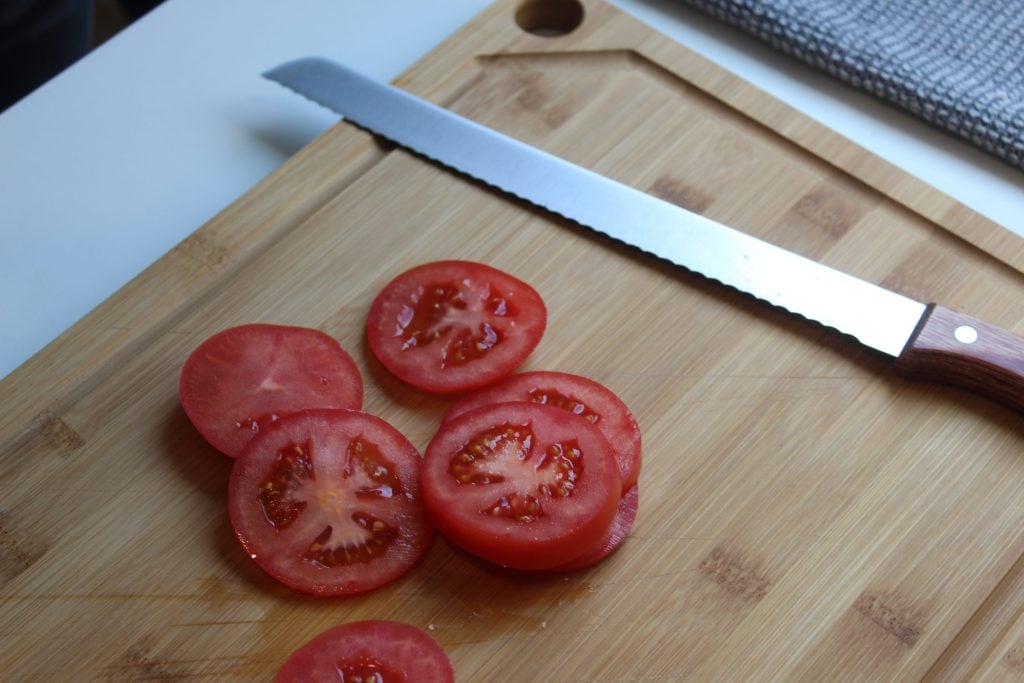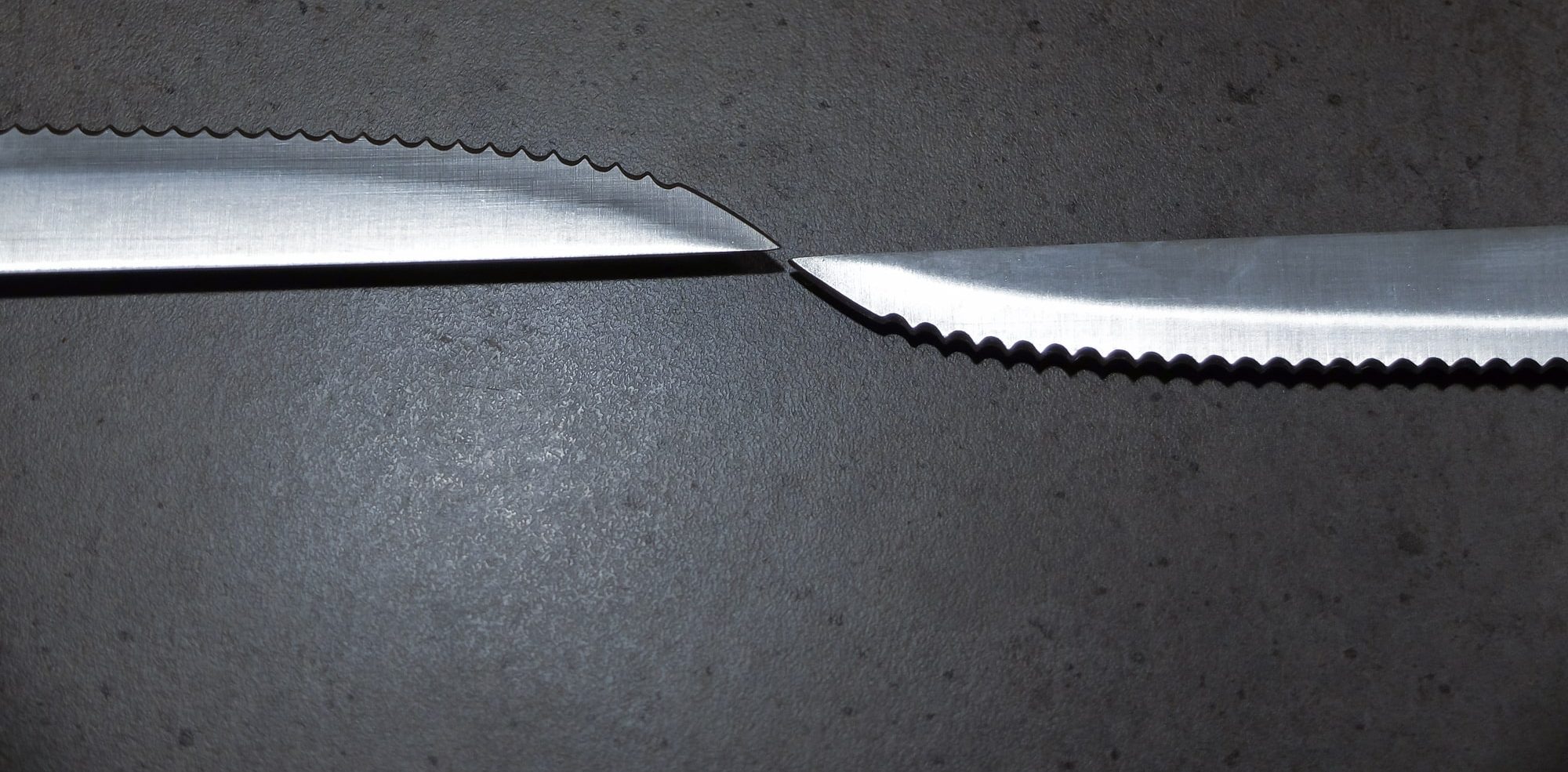Serrated-edged knives have an almost tooth-like appearance and are the perfect tool for slicing through ingredients with a hard outer shell hiding a soft interior. That is why serrated knives are frequently used for cutting into freshly baked bread or meats with crisp skins. It is essential to keep these blades sharp to catch and rip the outer layer and smoothly glide through the soft interior.

Can You Sharpen Serrated Knives?
Yes! Not only can you sharpen a serrated knife, but this is required to maintain its ability with tougher food ingredients. Luckily, a quality serrated knife will not need as much attention for sharpening as straight or flat blades in your home or professional kitchen.
What are the Best Sharpening Methods?
Two primary methods of sharpening a serrated knife include manual sharpening steel made from ceramic or steel or an electric sharpener (Note that the electric option is less accurate). The manual option is sometimes called honing steel because it doesn’t remove any materials from the blade but reshapes the edges.
The second method is to use an electric/automatic knife sharpener. There are plenty of high-quality electric sharpeners that work with serrated blades.
Tools for the Job
- Dull serrated blades to be sharpened.
- Honing/Sharpening Steel
- Automatic Sharpener
- Microfiber Cloth for Cleanup
- Protective Gloves (optional)
Recommended Method to Sharpen a Serrated Knife
Step 1: Start by finding the beveled side of your serrated knife. The beveled side is the non-flat part of the knife and is what you’ll sharpen.
Step 2: Take your sharpening steel and carefully run it through each tooth (gullet) by placing the rod flat against the angle of the beveled edge. You’ll need to repeat this until all the individual teeth are sharpened.
Step 3: You can clean away any small metal pieces that come off the flat side of the knife (known as burs) by wiping the blade against a whetstone or fine-grit sandpaper.
Step 4: Finish off the entire process by wiping down your serrated knife with a microfiber cloth and a small water drip to ensure it is completely clean and ready for food ingredients.

How to Sharpen Other Serrated Knives?
The primary methods of sharpening serrated knives will be similar, with only a slight difference depending on the use of the blade in question. You will need a little adjustment if you sharpen a bread knife compared to a steak knife.
1 – How to sharpen a serrated bread knife:
- Place the honing/sharpening steel in your hand and rest the tip on the counter or cutting board, so it is vertical.
- Run the serrated knife’s teeth down the length of the steel at the angle you wish to maintain.
- Stop when you feel a burr pushing to the non-angle side of the blade (usually a couple of swipes per tooth).
- Use the microfiber cloth and a tiny amount of water to clean any remnants from the edge and steel.
2 – How to sharpen a serrated steak knife:
- Use a sharpening rod with around 1,000 grit and hold your serrated knife with the edge pointed away from your body.
- Place the rod in the serration, trying to match the angle of the bevel.
- Slowly and gently draw the rod through the serration in a single direction.
- Repeat a few times per tooth or until you feel a burr.
- Use the microfiber cloth and a tiny amount of water to clean any remnants from the blade and steel.
3 – How to sharpen micro-serrated knives:
- Find the bevel side of the micro-serrated knife and get the tightest angle you can against the rod.
- Do not place a lot of pressure on the blade as you use the sharpener to pass through the micro-teeth.
- Try only one swipe at a time and test the sharpness to ensure you haven’t broken any of the micro-teeth.
- Continue until the entire serrated edge is sharpened.
- Use the microfiber cloth and a tiny amount of water to clean any remnants from the blade and steel.
*We should note that most micro-serrated knives market themselves as never needing sharpening. However, it is our experience that every blade gets dull over time.
As for an electric sharpener, all it takes is swiping the blade slowly and gently toward yourself through the grooves. Just be sure you are sharpening the flat side of the edge, not the scalloped side.
Additional Methods
Besides using a sharpening/honing steel or an electric sharpener, your next best option is to hire a professional knife worker. This could be the original manufacturer of your serrated knives or a local sharpener with the unique equipment and experience to get the job done well. This is because some serrated blades are tough to work between the teeth and require a bit more precision than what you may be prepared for at home.
Best Serrated Knife Sharpener

We suggest the Wusthof 10” Sharpening Steel for getting your serrated knives into working order. This high-quality sharpener is long enough to work with practically any serrated blade you have, from a bread knife to a steak knife. It is also highly affordable and pays for itself with fine grit and easy to grip handle for improved safety. This excellent combination of German engineering and Chinese manufacturing ensures your knives are sharp and ready for use.
Conclusion
Learning how to best sharpen serrated knives only takes a bit of practice and patience. With the right tools, you’ll be able to slide through the toughest baked bread and meats in no time. A quality-made sharpening/honing steel is your best option, but an electric sharpener will work in a pinch.
No matter which method you choose, be sure to take your time, so you avoid any accidents. Serrated edges can break off if too much pressure is applied, so slow down and choose a method that works best for your budget, lifestyle, and knife needs.




Post Your Thoughts